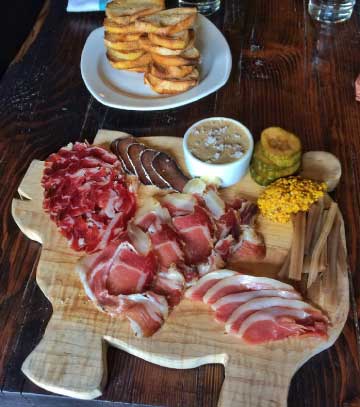Next story: Southern Tier Old Man Winter & Sierra Nevada Coffee Stout
From Grain to Charcuterie and Back Again
by Michael Chelus
How Beer Making Byproducrs Feed Western New York Restaurants
The much heralded Farm-to-table movement has been bringing locally grown produce and livestock directly to local diners in Western New York for many years. Another movement—or cycle—that delivers the same increased quality in production and involves local farms, restaurants and breweries, has not received the same popularity. In the last few years, several local breweries have been giving their spent grains from brewing to a notable local farm that supplies local restaurants. Talented local chefs then use these products in their cooking and produce dishes that not only taste great, but pair incredibly well with the beer that was made with the spent grain that started the cycle.



In exploring this cycle more deeply, we start with the local breweries. Community Beer Works (CBW), Resurgence Brewing Company (RBC) and Big Ditch Brewing Company (BDBC) all give their spent grains to T-Meadow Farm, a Lockport farm that raises antibiotic free heritage breed pigs. The breweries are able to rid themselves of a product that would be wasted otherwise and put it to a good use. T-Meadow Farm gets a product that allows it to produce a better kind of animal that suits the needs of local restaurants and chefs while allowing the animals to be raised in a healthy and humane way.
The spent grains are very beneficial for T-Meadow pigs according to owner, Rich Tilyou. The spent grain is “high in protein, and has a little sugar left in it for quick energy. It also has vitamin B,” said Tilyou. This allows his pigs to gain a “nice, firm fat” which is very desirable for chefs and diners.
Once they attain the proper weight and fat content, T-Meadow pigs are sold to local restaurants where they are used both respectfully and skillfully. A long time patron and advocate for T-Meadow Farm is Steven Gedra, chef and co-owner of The Black Sheep. Chef Gedra has made a name for himself—both at The Black Sheep and at his former restaurant, Bistro Europa—by using T-Meadow pigs in countless preparations and employing nose to tail cooking that has won him the hearts and stomachs of Western New Yorkers. From the Burro di Chianti made from lard from T-Meadow pigs that accompanies the breads made by his wife, chef and co-owner, Ellen Gedra, to a smoked T-Meadow pork chop that has appeared on The Black Sheep’s menu on several occasions, Chef Gedra’s menu is frequently filled with T-Meadow pork.
Another use for T-Meadow pork that Chef Gedra has locally championed is charcuterie or pork that is cured by salting and drying. Chef Gedra’s charcuterie board has changed throughout the years but is held together by one constant—T-Meadow pork. The current version has meat cured in both the French and Italian traditions and features Capicolla, Lonza and Rillettes. The Capicolla salted and cured for two months. Lonza made from the pork loin displays the work of the spent grain. Both would pair well with That IPA from CBW or Hayburner IPA from BDBC. The Rillettes, prepared like pâte was redolent with pork fat and stock and carried the aromatic flavors of thyme and garlic. This rich paste would pair well with Imperial Red IPA from RBC or The Whale Brown Ale from CBW. The effervescence, malts and hops in the varying styles of beer made with these grains each bring something different to the pairing. It’s not a coincidence that they naturally pair with these dishes and do so wonderfully.
Diners can enjoy equally delicious dishes made from T-Meadow pork prepared by Chef Jeffrey Cooke, Jr., executive chef and co-owner of Osteria 166. Chef Cooke is also quite accomplished with charcuterie and other dishes that are made better by the use of T-Meadow pork. For his charcuterie, Chef Cooke offers Spalla, a cured meat made from the fore shoulder of a T-Meadow pig. Cured for over a year, it has developed a wonderful red color and a deep pork flavor that pairs well with local beers with hop content, like CBW’s Frank American Pale Ale or RBC’s IPA. Chef Cooke’s Culatello is a wonderful homage to its cousin made in Italy which some covet more than Prosciutto di Parma. Its salinity and sweet pork flavor would be a natural pair with Low Bridge Hoppy Golden Ale from BDBC. Another dish in which Chef Cooke uses T-Meadow pork is in his Bolognese sauce. His version, made mostly from T-Meadow pork, was balanced and rich—the perfect accompaniment for properly cooked pasta. When paired with a darker beer like a brown ale, the deep caramelization obtained with the T-Meadow pork is highlighted.
The life cycle from spent grain to charcuterie that pairs well with local beer is as viable as farm-to-table cooking. It’s a process where everyone wins from the brewers to the restaurants to the diner. It’s just one more way to support and celebrate all that Western New York has to offer.
blog comments powered by Disqus|
Issue Navigation> Issue Index > v14n48 (Week of Thursday, December 3) > From Grain to Charcuterie and Back Again This Week's Issue • Artvoice Daily • Artvoice TV • Events Calendar • Classifieds |









 Current Issue
Current Issue